Gigabyte GA-EP45-UD3P - P45 at its Finest
by Gary Key on February 3, 2009 12:15 AM EST- Posted in
- Motherboards
Board Layout

Taking a quick tour around this board, we find the overall layout is excellent. The 24-pin and 8-pin ATX power connectors, floppy/IDE connectors, and several of the SATA ports are all placed along the edge of the motherboard. We would have preferred that the SATA connectors were in a 90 degree angle configuration, but they work as is. One nice feature is that there is a double slot gap between the two physical PCI-E x16 slots so that aftermarket cooling will work. Installation of our peripherals was easy and the board fit well in several case designs. The back of the board is clean and all of our various air coolers that required a back plate worked fine. Let’s take a quick look at the rest of the board.
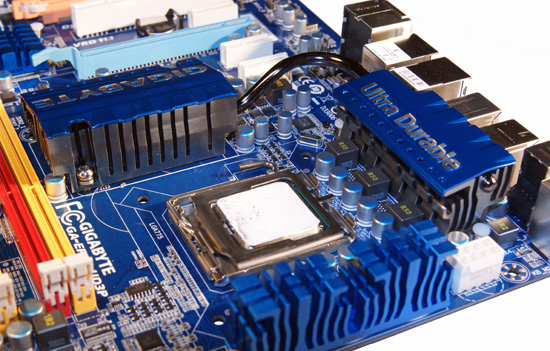
The CPU socket area is open and unobstructed for the most part. The socket area is surrounded by the Northbridge heatsink, MOSFET coolers, and several capacitors, but we had no issue installing large air coolers or a couple of water blocks. This board features a six-phase power design with three Low RDS(on) MOSFETs per channel along with the R50 ferrite core closed chokes.
Forget the marketing info about eight to sixteen phase power delivery systems; it is all about the quality of the components utilized. This board supports 30A per phase and delivers a total of 180A to the CPU. This is more than enough for any Core 2 processor in Intel’s lineup, even with heavy overclocking.
The chipset and MOSFET cooling system is well designed and works. Gigabyte connects the aluminum Northbridge heatsink to the primary MOSFET heatsink with a revised heatpipe design. The second MOSFET heatsink located on the edge of the board reminds us of Intel’s BadAxe designs. To answer the question of whether any of this works: yes, it works very well even with the system overclocked.
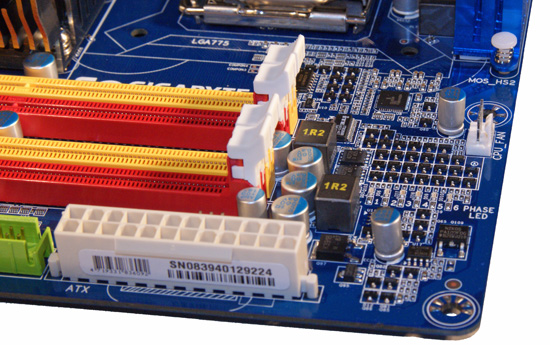
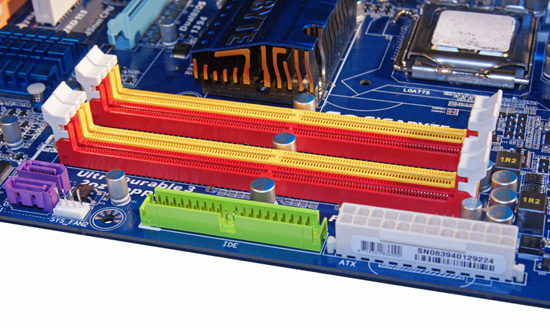
The top picture shows the phase LED setup that displays the number of power phases in use, but only when the Dynamic Energy Saver software is running. Located below the LED panel is the two-phase power system for the memory slot along with the CPU fan header that is slightly out of the way for us.
The second image shows the eye popping red and yellow memory slots. Fortunately for most of us, Gigabyte has changed to a muted color scheme on the X58 boards, but the Crayola color scheme lives on in this board. The floppy drive connector, 24-pin ATX power connector, and the two GSATA ports are located along the edge of the board.
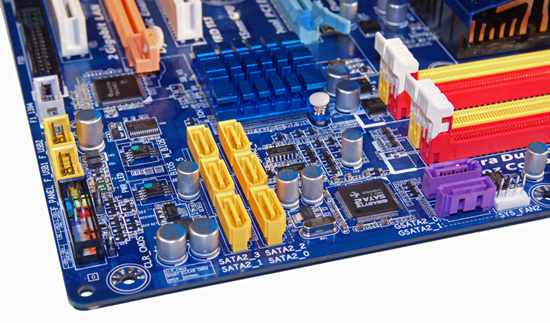
Hey, the two purple GSATA ports show up again. This rebranded JMicron controller is capable of RAID 0 and RAID 1 operation. Intel’s ICH10R provides support for the six yellow SATA ports and features RAID 0/1/5/10 capabilities with Intel’s excellent Matrix technology. The ICH10R is cooled by a low-rise aluminum heatsink . Along the left edge of the board is the black front panel connector, two yellow USB 2.0 headers, and the gray IEEE 1394a header.
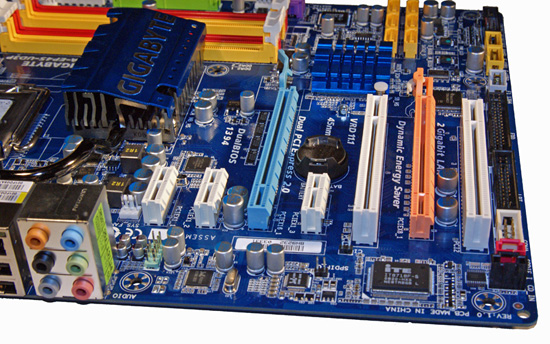
The expansion slot layout is very good and indicates that Gigabyte has been listening to users. The third PCIe x1 slot and second PCI slot become physically unusable if dual-slot graphics cards are placed in the PCIe x16 slots. Even so, with a CrossFire setup you end up with two PCIe x1 and one PCI slot open. You cannot ask for much more than that.
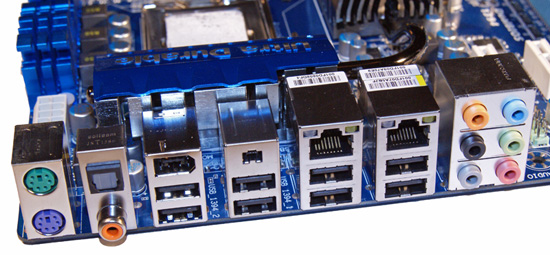
Last but certainly not least is the I/O panel. There are the standard issue PS/2 keyboard and mouse ports, two Gigabit LAN ports with LED activity lights, eight USB 2.0 ports, two IEEE 1394a ports, optical and coaxial S/PDIF ports, and an audio panel.
















73 Comments
View All Comments
djc208 - Tuesday, February 3, 2009 - link
Thanks for the review. Picked this board up for $100 w/ free shipping from Newegg a few months ago. Looked like a great board for the money, glad to see you agree.I'll have to go back and update my software though, I also didn't notice any real benefits to their power program, and the OC program would hang my XP system.
weh - Tuesday, February 3, 2009 - link
Did you happen to test the pair of GSata ports in addition to the Sata ports connected directly through the ICH10R? Are they equally as responsive?Also, if you were to attach a pair of drives in either RAID-0 or RAID-1 to the ICH10R Sata ports, is throughput to a third (or fourth) drive affected?
Two specific examples: 1) Two (2) VelociRaptors attached to Sata_0 and Sata_1 in a RAID-0 array containing OS and apps with data storage on a Caviar "black" 640GB drive attached to Sata_2; and, 2) A single VelociRaptor attached to Sata_0 containing OS and apps with a pair of Caviar RE3 drives in RAID-1 attached either to Sata_1 and Sata_2 or to GSata_0 and GSata_1.
Gary Key - Wednesday, February 4, 2009 - link
Hi,Yes, we tested the secondary controllers and I will update the article to include those results. We had a bit of trouble on the AMD board (Phenom II) getting consistent results but a BIOS update cured that problem last night. The X58 article linked in the above response will give you an idea about the secondary controller performance until I get the article updated.
Personally, I would only use the GSata (JMB363) ports as a last alternative but that is just me. Those ports are on the board as a marketing checklist feature. ;) We have not noticed any performance degradation on the ICH10R with a RAID setup on two ports and single drives on the other ports. Running drives off the GSata ports will not affect performance on the ICH10R ports, at least with a two drive configuration on the ICH10R and two drives on the GSata controller. I have not loaded all eight ports and tried that but that is a good question to answer in the future if I can get enough of the same drive model for testing.
weh - Wednesday, February 4, 2009 - link
Thank you for the response. I suspected that the GSata ports would behave much like those on the X58 board, but it's nice to know. By the way, your review of the X58 boards is the ONLY review I've been able to find on ANY review site that compared performance between "native" south bridge Sata ports and auxiliary Sata ports.I'm building four machines to be used by photography professionals. Performance is paramount, but so is redundancy. Each setup will consist of a computer with an os/applications drive (Velociraptor) and a pair of drives in RAID-1 for working space (either a pair of Caviar "blacks" or the RE3 units) and fourth drive inside the case used for continuous backups (probably one of the Caviar "green" drives). They also want 3 optical drives in each machine (they archive 3 of everything and want the ability to burn all 3 at once), so I'm running out of ports rapidly. I'll probably attach the three primary drives and the three optical drives to the six native sata ports and the backup drive and an eSata port to the two auxiliary GSata ports.
Zoomer - Tuesday, February 10, 2009 - link
I would recommend a SSD for OS/apps drive, but that's just me. Raptor? Slow. ;)The0ne - Tuesday, February 10, 2009 - link
Most definitely go with a stand alone CD duplicator. It's small, cheaper and easier to manage for what you've outlined.bobbyto34 - Monday, February 9, 2009 - link
You should perhaps consider buying a special "dedicated" computer for burning data. There are several robots (mechanized arms + software) to burn DVD/CD easily :example :
- connect to the robot via the software
- choose file + label for DVD print
- launch burning
New tasks are paused until their turn arrives.
Primera or Rimage provide these types of products.
semo - Tuesday, February 3, 2009 - link
to add to the questions above, what is gsata? and why do boards have 2 sata contollers these days. is it so tha one set can be used for os and app drives and the other set for high capacity data drives?review was good though and this board is smoking. plenty of peripheral slots and very well placed. with current oversupply and competition you can get cheapo memory, one of these boards and a mid range processor and overclock everything with relative ease. i don't thinkg we've had it so good since the amd barton core days
weh - Tuesday, February 3, 2009 - link
GSata is Gigabyte's add-on SATA controller, an additional controller for two additional SATA drives which can be run individually, in RAID-0 or in RAID-1. Gigabyte also includes an controller for a single channel parallel IDE (P-ATA) port (2 drives, master & slave).What I'd like to know is how drives connected to this alternate controller's ports compare in throughput to those connected to the "native" ICH10R Sata ports.
I also want to know if adding a RAID array pair affects the performance of a drive outside the array as compared to the drive's performance when the RAID array is not present at all. In other words, does the presence of a RAID array impede the performance of another drive connected to the same controller?
semo - Tuesday, February 3, 2009 - link
i don't know about the raid question (interesting to find out) but i know that the ich10r sata controller is pretty good and seems better than the secondary contollers.http://www.anandtech.com/mb/showdoc.aspx?i=3471&am...">http://www.anandtech.com/mb/showdoc.aspx?i=3471&am...